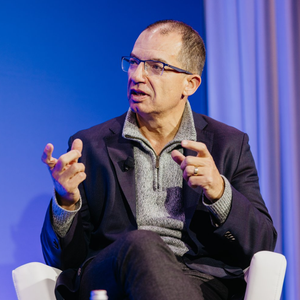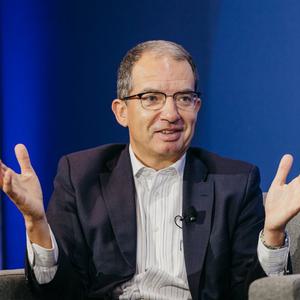
Moderna
We could instruct a patient’s own cells to produce proteins that could prevent, treat, or cure diseases?
We can design cellular software—in the form of messenger RNA— that allows people to make their own vaccines and medicines in a controllable and reversible way.
Picture a factory for making drugs: there are raw materials, carefully honed protocols, assembly lines where the drugs are put together or vats where they’re grown. There’s a foreman watching over production—specifying what to make, how much, and when. It’s all very complex. It’s also big: pharmaceutical factories can run to 800,000 square feet or more.
Now picture a drug factory the way Noubar Afeyan, the co-founder and chairman of Moderna and founder and CEO of Flagship Pioneering, has learned to see it: at about 25 µm in diameter, less than the width of a human hair.
This factory is a cell, and its foreman is messenger RNA (mRNA)—the molecule that ferries DNA’s instructions to the cell’s protein-making machinery. mRNA is poised to transform the pharmaceutical industry. By engineering new forms of the molecule, Moderna is working to create mRNA medicines to instruct a patient’s own cells to produce proteins that could prevent, treat or cure disease—and, says Afeyan, “every single cell in the body gets its instructions from mRNA.”
Origins
For a company with such a profound potential impact, Moderna is still relatively new. It got its start in spring 2010, when Afeyan met with Bob Langer, the prolific inventor and professor of chemical engineering at MIT. Langer wanted to talk to Afeyan about using mRNA to reprogram adult human fibroblast cells into induced pluripotent stem cells, enabling them to transform into other cell types, following the protocol of Shinya Yamanaka.
Afeyan found the project fascinating, but not because of the possibility of reprogramming adult cells. He was more interested in the process: specifically, the idea of using mRNA in previously unimagined ways. Academics had studied mRNA closely for decades, coming to understand its biological roles in fine detail. Many biotechnology and drug companies had modified other complex biological molecules such as plasmids and viral vectors before. But they hadn’t seriously attempted to engineer mRNA for use as a new kind of medicine.
Afeyan, a biochemical engineer by training, wanted to try. “I’d worked a lot on protein manufacturing innovations,” he says, “and a thought occurred to me in that meeting: “Why can’t we use mRNA so that the patient becomes a manufacturing facility for his own drugs?”
At the time, the idea seemed, Afeyan admits, “far afield.” But that made it a perfect candidate for Flagship’s pioneering approach of pursuing ideas beyond the innovations that incumbent companies typically seek.
Focus
Afeyan and Flagship Pioneering Managing Partner Doug Cole launched a months-long exploration inside Flagship Labs, the enterprise’s innovation foundry. At first, the venture was merely a numbered prototype company or “ProtoCo:” LS18. Afeyan and Cole quizzed other life scientists from Harvard and MIT about the idea’s feasibility. What they learned didn’t discourage them. Then, they brought in young researchers from the lab of Nobel laureate Jack Szostak, a pioneer of RNA manipulation, and gave them two big questions to tackle: Could we get patients to make their own protein biologics? And could mRNA be the basis for that?
Soon, the first two questions generated dozens more. When mRNA was put into cells, it caused an immediate immune response—why? (The answer wasn’t clear: the specific biochemical culprit hadn’t been identified.) Other types of RNA had been chemically modified before, to render them more stable in the bloodstream; could mRNA be modified in the same way? (No, it turned out: unlike the other RNAs, mRNA had to survive transcription from DNA and translation into proteins, and the modifications interfered with both processes.) If the previous modifications wouldn’t work, would others? (Maybe—but no one would know without animal experiments.)
The questions continued among the founding team at Flagship. “If you go into an animal with these mRNAs—and there was no animal data—where does the mRNA go? How much does it persist? Could you get enough of it into cells to make protein? Would the protein be correctly folded? If it was the correctly folded protein, would it be made in enough quantity to be therapeutically even remotely useful? And how would you figure it out? The tools didn’t exist.”
Three months in, the team had no easy answers—just hard questions and blue sky. For many entrepreneurs, this might have been the time to back out. But at Flagship, the team could imagine unprecedented answers to all the questions—as well as enormous commercial potential. With so little previous research in existence, practically everything Flagship did would be patentable.
In early 2010, LS18 was renamed Moderna and its scientists moved into a lab on First Street in Cambridge, Mass. They spent the next six months injecting rats with different combinations of modified mRNAs. It was not glamorous work. Nor was it an immediate success: as the team anticipated, most of the mRNA molecules didn’t survive transcription and translation. But a few of them did. Some of the rats’ cells started producing proteins that they wouldn’t have otherwise made, first in tiny amounts, then in larger ones. That was enough to move forward, says Afeyan: “Gradually, gradually, we convinced ourselves.”
On First Street, Moderna began the hard work of building a company. Flagship’s VentureLabs group filed provisional patents in July and October 2010. Stéphane Bancel who had been Chief Executive Officer of the French diagnostics company bioMérieux SA, joined Moderna’s board of directors in March 2011, and became its CEO in October, 2011.
Breakthrough
Today, those early experiments have evolved into a panoply of potential medicines, including a personalized cancer vaccine (with Merck), a suite of investigational medicines designed to provoke the body’s immune system into attacking cancer tumors, a development candidate that could help the body regenerate blood vessels (with AstraZeneca), and a program that seeks to leverage the liver to manufacture enzymes for rare disease patients who were born without the ability to make those enzymes on their own. Best known, of course, are Moderna’s vaccines against infectious diseases, including mRNA-1273, the vaccine against the Novel coronavirus (SARS-CoV-2), which was granted emergency use authorization in December, 2020. In all, the company now has 21 programs in its pipeline with 11 in clinical development. Moderna’s mRNA platform builds on continuous advances in basic and applied mRNA science, delivery technology, and manufacturing, with the goal of creating a new class of medicines: or as Afeyan describes it “a potential revolution in the making.”
Advantage
To get here, Moderna’s scientists have doggedly pursued answers to the questions that seemed so daunting in the summer of 2010. For instance: the company realized early on that the immune system was identifying mRNA as foreign and hostile, and reacting by shutting down protein production—the very thing these potential drug candidates were supposed to increase. The problem took years to solve, but Moderna has now developed proprietary ways to package mRNA so it can evade the immune system and deliver it to the right cells in the body, and has demonstrated the ability to repeatedly dose therapeutics for rare diseases in animals.
Afeyan freely admits that the mature company has expanded beyond its original vision. Vaccines weren’t a major focus in 2010; they ended up being some of the first things Moderna took into the clinic. Combination therapies weren’t on the radar in 2010 either; today, many of the company’s candidates use combinations of mRNAs to make complex proteins, using multiple encoded mRNAs in a single injection. “We’re learning and learning,” says Afeyan.
Will there be more questions? Of course. But there are also answers—today, for Moderna’s scientists, and someday soon, for patients.
Moderna Timeline
Latest News from Moderna
- Flagship Pioneering Names Stephen Hoge 2023 Pioneering Leader of the Year 11.21.2023
- Moderna Announces Positive Interim Phase 1 Data for its mRNA Vaccine (mRNA-1273) Against Novel Coronavirus 05.18.2020
- François Nader, M.D., Joins Moderna’s Board of Directors 12.10.2019
- Moderna Named Top Employer by Science for Fifth Consecutive Year 10.24.2019
- Moderna Receives FDA Fast Track Designation for Propionic Acidemia Program (mRNA-3927) 10.22.2019
- Moderna to Present Data From Two of Its Prophylactic mRNA Vaccines at IDWeek 2019 10.02.2019



